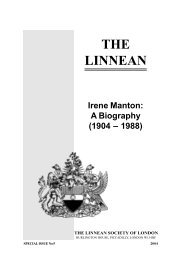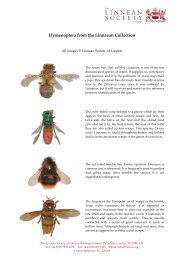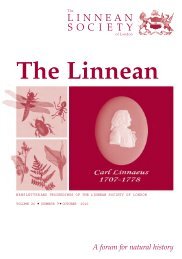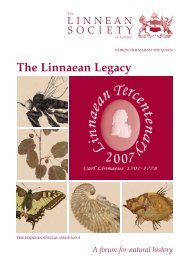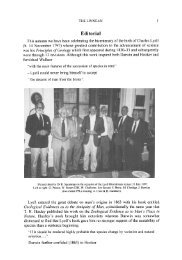Vol 25, no 3, October - The Linnean Society of London
Vol 25, no 3, October - The Linnean Society of London
Vol 25, no 3, October - The Linnean Society of London
Create successful ePaper yourself
Turn your PDF publications into a flip-book with our unique Google optimized e-Paper software.
40<br />
THE LINNEAN 2009 VOLUME <strong>25</strong>(3)<br />
vegetation, a view encouraged by Henslow in a letter to Darwin written on 15 January<br />
1833 “…<strong>The</strong> Lichens are good things as scarcely any one troubles himself to send<br />
them home…” (Burkhardt & Smith 1985: 294; Porter 1987: 149). Darwin’s lichens<br />
were sent by Henslow to the mycologist M.J. Berkeley, Darwin <strong>no</strong>ting in a letter to<br />
Joseph Hooker on 11 January 1844 “…My cryptogamic collection was sent to Berkeley;<br />
it was <strong>no</strong>t large; I do <strong>no</strong>t believe he has yet published an account but he wrote to me<br />
some year ago that he had described & mislaid all his descriptions. W d it <strong>no</strong>t be well<br />
for you to put yourself in communication with him; as otherwise some things will<br />
perhaps be twice laboured over. – My best (though poor) collection <strong>of</strong> the Cryptogam.<br />
was from the Cho<strong>no</strong>s Islands…” (Burkhardt & Smith 1987: 2).<br />
On 29 January 1844 Hooker wrote to Darwin “…M r Berkeley was with us shortly<br />
before your letter arrived, & I gave him all my Fungi, he has returned me for M r<br />
Henslow your Lichens, which he had; but said <strong>no</strong>thing about the other orders in his<br />
possession…”(Burkhardt & Smith 1987: 6). Thus, Darwin’s lichens went to Kew<br />
where Hooker made extensive use <strong>of</strong> them during the preparation <strong>of</strong> his Flora<br />
Antarctica, the first part <strong>of</strong> his Botany <strong>of</strong> the Antarctic Voyage. Hooker enlisted the<br />
help <strong>of</strong> the Irish liche<strong>no</strong>logist, Thomas Taylor for determination <strong>of</strong> his lichen collections<br />
from the southern zone (Hooker & Taylor 1844), and Taylor later described several<br />
new species from Darwin’s Beagle collections (Taylor 1847 – see below).<br />
Taylor’s lichens, which include duplicates <strong>of</strong> some Darwin collections, are held in<br />
the Farlow Herbarium <strong>of</strong> Harvard University (FH), but the bulk <strong>of</strong> Darwin’s lichens<br />
are to be found scattered through the General Collection, and in the unincorporated<br />
collections <strong>of</strong> the Lichen Section <strong>of</strong> the Natural History Museum in <strong>London</strong> (BM). An<br />
additional, and as yet untapped, source <strong>of</strong> Darwin lichens is also in the Natural History<br />
Museum. On Darwin’s rock specimens held in the basement corridor drawers <strong>of</strong> the<br />
Department <strong>of</strong> Mineralogy, many <strong>of</strong> them from remote places never visited (or likely<br />
to visited) by a liche<strong>no</strong>logist, there are sometimes mosaics <strong>of</strong> lichens present. <strong>The</strong>se<br />
Darwin specimens would richly repay a liche<strong>no</strong>logist’s attention. Notes on the various<br />
Darwin lichen collections that I was able to find in the BM between 1973 and 1994,<br />
supplemented with relevant accounts from the literature are given below.<br />
1. Fernando de Noronha: On 19 February 1832, the Beagle was <strong>of</strong>f Fernando de<br />
Noronha, Darwin <strong>no</strong>ting in his Diary “... An hour before sunset Fernando was clearly<br />
visible – it appears an extraordinary place, – there is one l<strong>of</strong>ty mountain that at a<br />
distance looks as if it were overhanging…”. <strong>The</strong> next day Darwin spent a few hours<br />
on the island, commenting his Diary “…I spent a most delightful day in wandering<br />
about the woods. – <strong>The</strong> whole island is one forest, & is so thickly intertwined that it<br />
requires great exertion to crawl along….I am glad that I have seen these islands, I<br />
shall enjoy the greater wonders [<strong>of</strong> the tropical rainforest] all the more from having a<br />
guess what to look for…” (Keynes 1988: 39). And in his Journal he <strong>no</strong>ted “…<strong>The</strong><br />
whole island is covered with wood; but from the dryness <strong>of</strong> the climate there is <strong>no</strong><br />
appearance <strong>of</strong> luxuriance…” (Darwin 1845). From the highest peak he collected the<br />
basidiolichen Dictyonema glabratum (Berkeley 1842: 445 – recorded as Cora pavonia<br />
– see also Porter 1987: 158).<br />
2. Brazil: on 5 April 1832 the Beagle landed at Rio de Janeiro and stayed there<br />
until 5 July. Darwin’s Brazilian lichen collections [the specimens seen in BM have a



